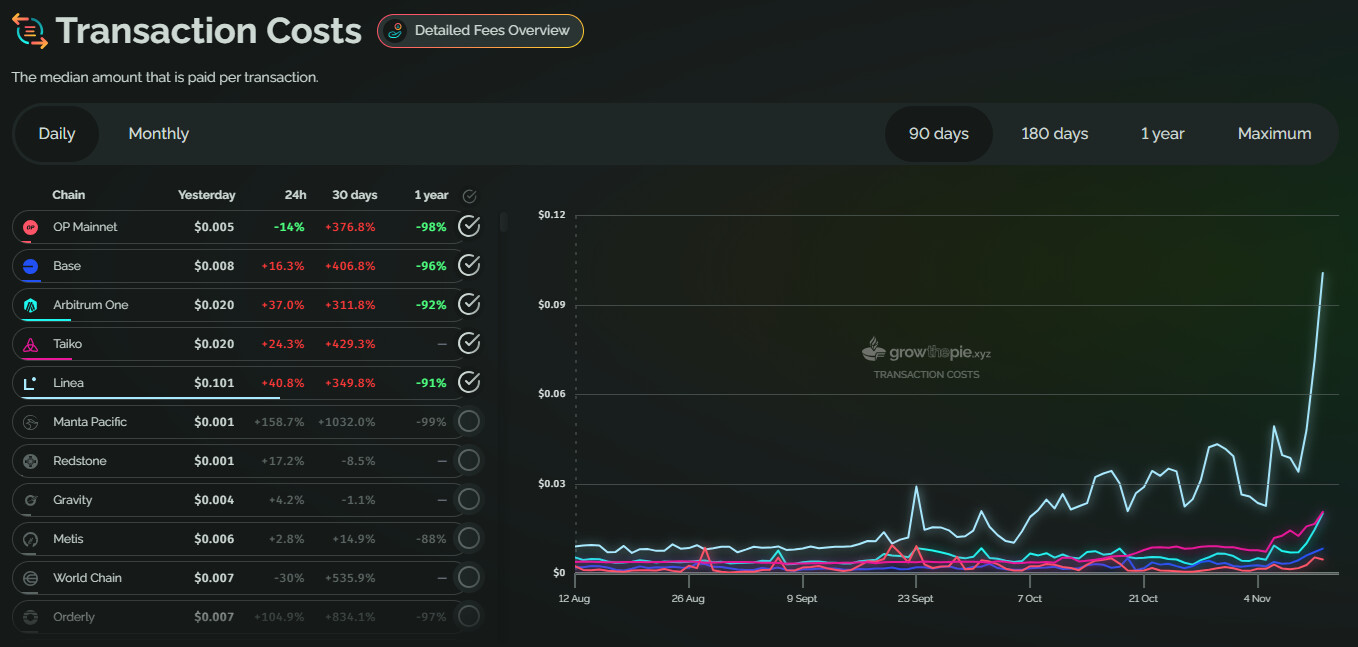L2 Chains Seeing Increased Fees Amid Market Frenzy
L2 chains are experiencing a surge in fees, marking a significant shift from their usual low-cost transactions. With fees on the rise, users are facing higher costs for transactions on leading L2 chains, all vying for a spot on Ethereum’s network.
After months of minimal fees, major L2 chains have implemented fee hikes, impacting end users who now have to bear the brunt of these increased costs. Even chains like Base, known for their low fees, have seen a notable uptick in transaction expenses. For users conducting high-frequency transactions or engaging in complex tasks, the relatively scalable L2 chains may no longer offer the cost-effective solutions they once did.

Arbitrum fees have risen due to stablecoin inflows and heightened demand for DEX and DeFi activities. | Source: Growthepie
Optimism and Arbitrum now charge $0.09 for transactions, with priority fees costing even more. While fees may fluctuate, recent weeks have seen the end of almost free transactions. Blobs have surpassed target levels more frequently in October and November, leading to competitive pricing for applications, chains, and contracts vying for block space.
The biggest fee hike has been observed on Arbitrum, driven by a resurgence in DeFi activities, particularly with Aave V3 lending gaining traction. As the most widely used L2 chain for its speed and low fees, Arbitrum has also attracted increased USDT activity, resulting in a significant shift in fees.
L2 chains have also started paying higher fees to Ethereum, with Taiko leading the way. Fees to L1 have surged 5-6 times for most chains in the past week, signaling the end of virtually free blob posting. Additionally, unidentified blob posters have utilized L1 to secure their finalized state, further intensifying competition for block space.
As the number of small L2 chains surpasses 100, any uptick in activity can lead to a more competitive blob market. In recent days, blobs have filled up faster, prompting chains to compete for space. While some L2 chains have reduced blob postings, the issue persists. Despite this, most L2 chains continue to generate significant revenue, paying only a few thousand dollars to ETH.
ETH Fees Soaring Amid Market Peak
The surge in fees on Ethereum comes amidst heightened crypto activity, with the network seeing 1.29 million transactions per day, up by approximately 30% in recent days. Gas fees on Ethereum have risen, with regular transactions costing up to $5.72 and DEX swaps and NFT sales carrying hefty fees.
The increased fees align with a spike in DEX activity following a price boom for several Ethereum-based tokens. Ethereum, which last saw such high usage during the Dencun upgrade in March, has experienced a reduction in inflation to 0.12%, significantly lower than in previous months. The network’s increased burns could potentially pave the way for a return to a deflationary structure.
While base fees on Ethereum have hit a 30-day high, ETH remains relatively affordable for L2 chains and applications, with costs ranging up to a few thousand dollars per day. However, Ethereum’s L1 network continues to face scalability challenges, with fees spiking rapidly during periods of heightened activity.












